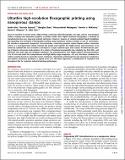Ultrathin high-resolution flexographic printing using nanoporous stamps
Author(s)
Kim, Sanha; Sojoudi, Hossein; Zhao, Hangbo; Mariappan, Dhanushkodi Durai; McKinley, Gareth H; Gleason, Karen K; Hart, Anastasios John; ... Show more Show less
DownloadGleason_Ultrathin high.pdf (11.10Mb)
PUBLISHER_CC
Publisher with Creative Commons License
Creative Commons Attribution
Terms of use
Metadata
Show full item recordAbstract
Since its invention in ancient times, relief printing, commonly called flexography, has been used to mass-produce artifacts ranging from decorative graphics to printed media. Now, higher-resolution flexography is essential to manufacturing low-cost, large-area printed electronics. However, because of contact-mediated liquid instabilities and spreading, the resolution of flexographic printing using elastomeric stamps is limited to tens of micrometers. We introduce engineered nanoporous microstructures, comprising polymer-coated aligned carbon nanotubes (CNTs), as a next-generation stamp material. We design and engineer the highly porous microstructures to be wetted by colloidal inks and to transfer a thin layer to a target substrate upon brief contact. We demonstrate printing of diverse micrometer-scale patterns of a variety of functional nanoparticle inks, including Ag, ZnO, WO[subscript 3], and CdSe/ZnS, onto both rigid and compliant substrates. The printed patterns have highly uniform nanoscale thickness (5 to 50 nm) and match the stamp features with high fidelity (edge roughness, ~0.2 μm). We derive conditions for uniform printing based on nanoscale contact mechanics, characterize printed Ag lines and transparent conductors, and achieve continuous printing at a speed of 0.2 m/s. The latter represents a combination of resolution and throughput that far surpasses industrial printing technologies.
Date issued
2016-11Department
Massachusetts Institute of Technology. Department of Chemical Engineering; Massachusetts Institute of Technology. Department of Mechanical EngineeringJournal
Science Advances
Publisher
American Association for the Advancement of Science (AAAS)
Citation
Kim, S. et al. “Ultrathin High-Resolution Flexographic Printing Using Nanoporous Stamps.” Science Advances 2.12 (2016): e1601660–e1601660.
Version: Final published version
ISSN
2375-2548